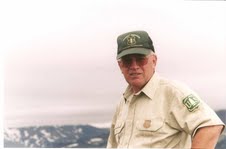Guest post by Les Joslin
Few would dispute the notion that the National Forest System and the U.S. Forest Service are impaled on the horns of a dilemma of dysfunction. On one horn is the lack of a clear-cut role for the national forests. On the other is the lack of an agency staffed by professional forest officers at all levels able to efficiently and effectively manage those lands.
As a consequence, one of our nation’s great treasures, the 193-million-acre National Forest System established by President Theodore Roosevelt and Forester Gifford Pinchot early in the 20th century and managed for its citizen-owners by the Forest Service for the past 105 years, is at risk. At risk with them are the commodity resources—clean water, timber, livestock forage, wildlife habitat—and amenity resources—scenery, outdoor and wilderness recreation, and more—that benefit all. In the West, close to 70 percent of domestic water originates in the forests. Also at risk is the economic survival of hundreds of rural communities that depend on the forests for jobs created by renewable resources and by recreation.
The role of the National Forest System, of course, is a matter of law. Indeed, of laws—too many and often conflicting laws. Evolution of a clear-cut role for the national forests is as critical as it would be complicated. It would depend on a successful legislative review and revision of these myriad laws to produce a more workable definition and implementation of that role. This is a challenge to the political will of our nation.
Successful meeting of this challenge would produce a revised and realistic legal framework for the National Forest System and for the smaller and more efficient and effective Forest Service necessitated by the get-real-about-deficit-reduction future faced by the U.S. Government and the American people as the United States careens toward national bankruptcy. This would support a revised forest planning rule that would prioritize and implement the community relations and resource management field work that needs to be done and would not be driven by selfish interests and peripheral considerations.
Whatever the role of the National Forest System, a truly viable U.S. Forest Service would have a well-defined national forest management mission implemented by leaders who lead effectively and followers learning to lead effectively—a professional corps of line and staff officers with field savvy and agency panache who understand and practice the art and science of, as the Forest Service’s own motto puts it, “caring for the land and serving people.”
This would be a corps of capable and competent “forest rangers” present and visible in the forests rather than hidden away in offices; supported by rather than subservient to technologies; doing jobs rather than outsourcing them. This would be a corps that capitalizes on rather than squanders its proud heritage, and attracts rather than alienates those who would serve in it rather than just work for it. This would be a corps worthy of the admiration and respect and support of the National Forest System citizen-owners who should be served and would be served by it.
The functional Forest Service of yore grew its own corps of forest officers—dedicated professionals and technicians—on mostly rural or remote ranger districts on which the district ranger depended on each and every member of his small crew to ride for the brand and pull his or her own weight to “get it done” together. But most such ranger districts have been lost to consolidation and urbanization and cultural change. And the generalists they grew have been replaced by more narrowly-focused specialists.
Developing such a corps is the essential challenge for the Forest Service leadership and its U.S. Department of Agriculture masters.
Without such ranger districts offering the formative experiences and training they once did, the Forest Service should train qualified men and women selected to serve as forest officers at a national, residential U.S. Forest Service Academy situated on a national forest that could accommodate and provide and materially benefit from—much as teaching hospitals do with medical students—a wide range of rigorous academic and field experiences. This academy would comprise an entry-level officer candidate school and a mid-career advanced course. And, during its earlier years, it would conduct a short update course for current district rangers.
At the officer candidate school, those recruited to be the line and staff professionals and leaders of the Forest Service would learn to be forest officers first and specialists in one or more relevant disciplines—in which they already would have academic degrees or significant experience—second.
The challenging course would inspire the will, inform the intellect, and develop the physical and practical and philosophical wherewithal of a corps of professional and technical members—not employees, but members—who would be the able and willing and dedicated forest officers required by the Forest Service. After significant career assignments and experiences, these forest officers could return to the academy for mid-career training to further their preparation for district ranger and senior line as well as staff assignments. The academy would be an intellectual and cultural wellspring of the Forest Service, an institutional home of the resolve and resourcefulness the Forest Service needs to succeed at any well-defined mission revised laws would prescribe.
Now is the time to act. It’s too late for a business-as-usual, study-it-again-sometime, put-it-off-until-somebody-else-is-President-or-Secretary-or-Chief approach. The national treasure that is the National Forest System is at risk now, the Forest Service is in extremis now, and the time for action—real action leading to early results to save both the System and the Service for the citizen-owners of the former and the good people of the latter—is now!
Audacious? Yes! Expensive? Yes! But certainly not too expensive for a U.S. Government that allocates hundreds of billions of dollars to rescue Wall Street and spends over two billion dollars (in 1997 dollars) per copy for B-2 Spirit stealth bombers. Indeed, the entire proposed U.S. Forest Service overhaul process could be funded and the entire proposed U.S. Forest Service Academy could be established and operated for a decade or two for half the cost of just one of those bombers.
Expensive? Yes, except when one considers that the value of the national forests to their citizen-owners is in the trillions of dollars, and that these lands are the source of life-supporting water for millions of people and myriad other values for millions more.
Expensive? Yes, except when compared with the millions of dollars spent on wildfires and the billions of dollars in damages to the land and citizens resulting from these holocausts.
Expensive? Yes, except when compared with the opportunity costs of the bureaucratic equivalent of fiddling while Rome burns.
Isn’t a truly effective investment in the future administration of the National Forest System and all the benefits derived by its citizen-owners in terms of commodity and amenity resources as well as jobs and more stable communities worth at least that much?
Impossible? Only if we tell ourselves it is, roll over, and give up.
Les Joslin is a retired U.S. Navy commander and former U.S. Forest Service firefighter, wilderness ranger, and staff officer. He teaches wilderness management for Oregon State University, writes Forest Service history, and edits the Pacific Northwest Forest Service Association’s quarterly OldSmokeys Newsletter. He lives in Bend, Oregon.


